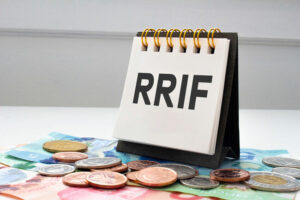In Part 1 of our Retirement Series, we explored the basics of Registered Retirement Income Funds (RRIFs). We will now delve into understanding the tax implications of the Registered Retirement Income Fund (RRIF) upon the death of its holder.
When an RRIF annuitant passes away, the standard protocol is to consider the fair market value of the RRIF assets at the time of death as having been received by the deceased. This implies that it is as if the deceased liquidated the RRIF assets just before passing away, and the tax liabilities will be reflected on their final tax return.

Specific Exceptions
If the deceased had a spouse or common-law partner at the time of their passing, they might not be taxed on the RRIF withdrawal if:
- The RRIF contract or the deceased’s will name the spouse as the sole beneficiary of the RRIF.
- The RRIF assets are directly transferred to a Registered Retirement Savings Plan (RRSP), another RRIF, or a qualifying plan or are used to purchase an annuity for the surviving spouse. This transfer must be completed by December 31st of the year following the death.
In such cases, the surviving spouse will receive a T4RIF slip indicating the RRIF amount in box 16. This denotes that the tax liability has shifted from the deceased to the surviving spouse. Concurrently, the surviving spouse will receive a receipt for the sum transferred to their own RRSP or RRIF, enabling them to claim a deduction. The combined effect of these documents ensures that the surviving spouse does not face immediate tax dues on the RRIF sum. Instead, taxes will be due when withdrawals occur in the future.
In light of these intricacies, it’s prudent to periodically review your RRIF or RRSP beneficiary details with your financial institution and ensure they align with your will. Equally crucial is seeking expert tax advice both before and following the demise of a loved one to prevent unforeseen tax complications.
When managing your Registered Retirement Income Fund (RRIF), one of the primary concerns is ensuring a seamless and tax-efficient transition of assets upon one’s death. By designating your surviving spouse or financially dependent child as a beneficiary, you can effectively circumvent a tax liability on your RRIF upon your demise.
An Alternative Approach
In the context of a RRIF (this does not apply to RRSPs), there’s an additional, lesser-known option: designating your spouse as the “successor annuitant” rather than merely a beneficiary. This allows the RRIF to remain intact posthumously, with your spouse assuming the role of the annuitant. This method is more streamlined from an administrative perspective.
Strategically, making your spouse the successor annuitant offers you posthumous control over RRIF assets. For instance, you can ensure that while your surviving spouse continues to draw an income from the RRIF, the remaining balance is bequeathed to your children upon your spouse’s death. This can be executed by naming your spouse as the successor annuitant and the children as irrevocable beneficiaries. In such an arrangement, any significant changes to the RRIF would require written consent from these irrevocable beneficiaries.
It is important to note that if your spouse predeceases you or there’s a change in marital status at your death, the RRIF contract will cease, redirecting the assets to the irrevocable beneficiaries. Due to the intricacies involved, consultation with a lawyer is advisable to evaluate this strategy’s merits and potential challenges for your unique situation.
Something to Consider
Regarding mandatory RRIF withdrawals, it’s essential to assess the long-term implications. Typically, deferring RRIF withdrawals to minimize tax liability is recommended. However, an early withdrawal, followed by strategic reinvestment into a Tax-Free Savings Account (TFSA), might be beneficial in specific scenarios. This strategy may be advantageous if you anticipate a higher marginal tax rate upon your demise than current rates, foresee substantial remaining RRIF assets after you and your spouse have passed, and have unutilized TFSA contribution capacity. For those anticipating significant taxes upon death or possessing unutilized TFSA contribution room, considering a reallocation from the RRIF to a TFSA may be advantageous. Proper financial planning and consultation are crucial in making informed decisions.
Summary
1. Standard Protocol upon Death of RRIF Holder: The fair market value of RRIF assets at the time of death is treated as if the deceased received it. The deceased is thus considered to have liquidated the RRIF assets just before death, with tax liabilities on their final tax return.
2. Exceptions for Surviving Spouse or Common-Law Partner:
- No tax on RRIF withdrawal if the spouse is named the sole RRIF beneficiary or if RRIF assets are transferred to another RRSP, RRIF, qualifying plan, or used to purchase an annuity for the surviving spouse by the end of the next year.
- The surviving spouse gets a T4RIF slip indicating the shifted tax liability. Taxes will be due for the spouse upon future withdrawals.
3. Beneficiary Review: Regularly check RRIF/RRSP beneficiary details with financial institutions to align with one’s will. Seeking tax advice before and after a loved one’s death is crucial.
4. Ensuring Tax-Efficient Transition: By naming a spouse or financially dependent child as a beneficiary, tax liabilities on the RRIF can be bypassed upon death.
5. Successor Annuitant Approach: A less common option, one can name a spouse as the “successor annuitant” instead of just a beneficiary. This means the RRIF remains intact after death, with the spouse becoming the annuitant. Posthumous control over RRIF assets can be maintained this way.
6. Issues to Reflect Upon:
- RRIF withdrawals: While generally deferring RRIF withdrawals is tax-efficient, early withdrawals with strategic reinvestments into a Tax-Free Savings Account (TFSA) can be beneficial under certain conditions.
- Proper financial planning and consultation are vital for informed decisions regarding RRIF management.








